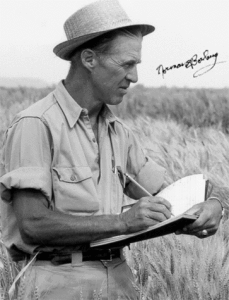Celebrating Norman E. Borlaug
 Today would have been Norman E. Borlaug’s 102nd birthday. He died in 2009 after an enormously productive life of helping others to help themselves. Known as the “father of the Green Revolution” for introducing high-yield wheat varieties to impoverished economies, his work was recognized with a Nobel Peace Prize among other awards for “the man who saved a billion lives”.
Today would have been Norman E. Borlaug’s 102nd birthday. He died in 2009 after an enormously productive life of helping others to help themselves. Known as the “father of the Green Revolution” for introducing high-yield wheat varieties to impoverished economies, his work was recognized with a Nobel Peace Prize among other awards for “the man who saved a billion lives”.
I like the photo here because it evokes the academic scribbler side of his entrepreneurship but also the gritty, hard work that was necessary to make his ideas succeed. To celebrate, I excerpt the last chapter of Madmen, Intellectuals, and Academic Scribblers, which begins with Borlaug’s story.
Chapter 7: What is to Be Done? Assembling the Wisdom
1. Ideas and the Human Condition
In the 1960s, farmers in India and Pakistan produced far too little grain to feed their people, and experts predicted mass starvation. It didn´t happen. Instead, a humble plant pathologist named Norman Borlaug (1914-2009) came up with a bold innovation: high-yield, disease-resistant wheat. Away in far-off Mexico, a country that imported a significant portion of the grain it consumed, Borlaug toiled and perfected his innovation—a hybrid wheat with a shorter stalk that could bear the weight of more grain. It would eventually produce soaring yields in India and Pakistan, turn Mexico into a grain exporter, and launch a “green revolution” that over four decades would double the world´s wheat production.[i] Awarded the Nobel Peace Prize in 1970, Borlaug´s contributions saved perhaps a billion people from starvation.
Norman Borlaug’s story seems too good to be true, a great idea that directly improves the human condition, without the messy details. What interests would stand in the way of feeding hungry people? Yet Borlaug faced many obstacles. Environmentalists wanted his hybrid plant to be banned. Bureaucrats in India´s agriculture office responded with skepticism. Customs officials in India were loath to let unknown seeds into their country. Even U.S. politics complicated the picture, as riots in Los Angeles threatened the timely shipment of seeds.
Borlaug pushed back, lobbying politicians and peasants alike. At first, just a few Indian farmers and a prominent bureaucrat planted his seeds. But after finding those initial loose spots, the higher yields of these pilot projects caught the attention of other farmers. Soon, there was a mass cry for the new seeds, and the rules of the game changed.
While we started this book with Danny Biasone saving basketball, we end it with Norman Borlaug saving a billion lives. These stories are not that different. Both faced vested interests, which were reinforced by popular beliefs that things should be a certain way. That is, until a better idea came along.
In this closing chapter, we assemble the lessons learned and use our framework to review the elements that combine to create political change. We illustrate how people see and seize opportunities to effectuate this type of change, whether at the level of ideas, institutions or incentives. Sometimes it takes the courage of a Mart Laar walking on water. Sometimes it takes the alertness of Alfred Kahn and Teddy Kennedy. And usually in the mix there is an academic scribbler, a Ronald Coase or a Paul Samuelson, patiently sowing the intellectual seeds of a revolution to come.
As we have described it in this book, political change generally involves key players and inputs. Ideas are conceived by the brilliant (and not-so-brilliant) minds of Keynes’s academic scribblers, from Aristotle and Aquinas, Machiavelli and Marx, and Hayek to Keynes himself. These innovative ideas then circulate in society, where they face off with vested interests and long-held beliefs in an attempt to change the institutional rules of the game which shape people’s incentives. These incentives, in turn, have a direct impact on outcomes in society. It is through these channels that ideas have consequences.
The process can be revolutionary, creating new institutions through a crisis, such as a war or a revolution. Lenin and the Bolsheviks come to mind; so do the American Founders. At other times, this process can be evolutionary, not born out of a crisis but emerging as part of a non-violent battle of ideas.
[i] Gregg Easterbrook, “Forgotten Benefactor of Humanity,” Atlantic Monthly, January 1997, accessed December 4, 2011, http://www.theatlantic.com/magazine/archive/1997/01/forgotten-benefactor-of-humanity/6101.
Happy birthday, Norman E. Borlaug.
